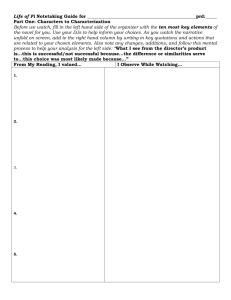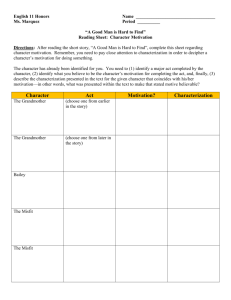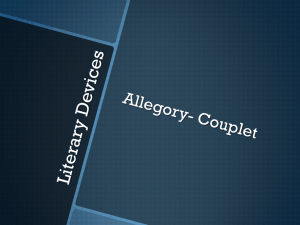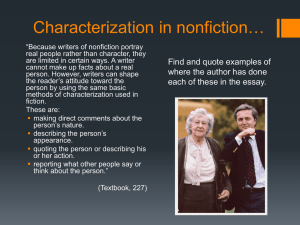LP Feb 10 Characterization
advertisement
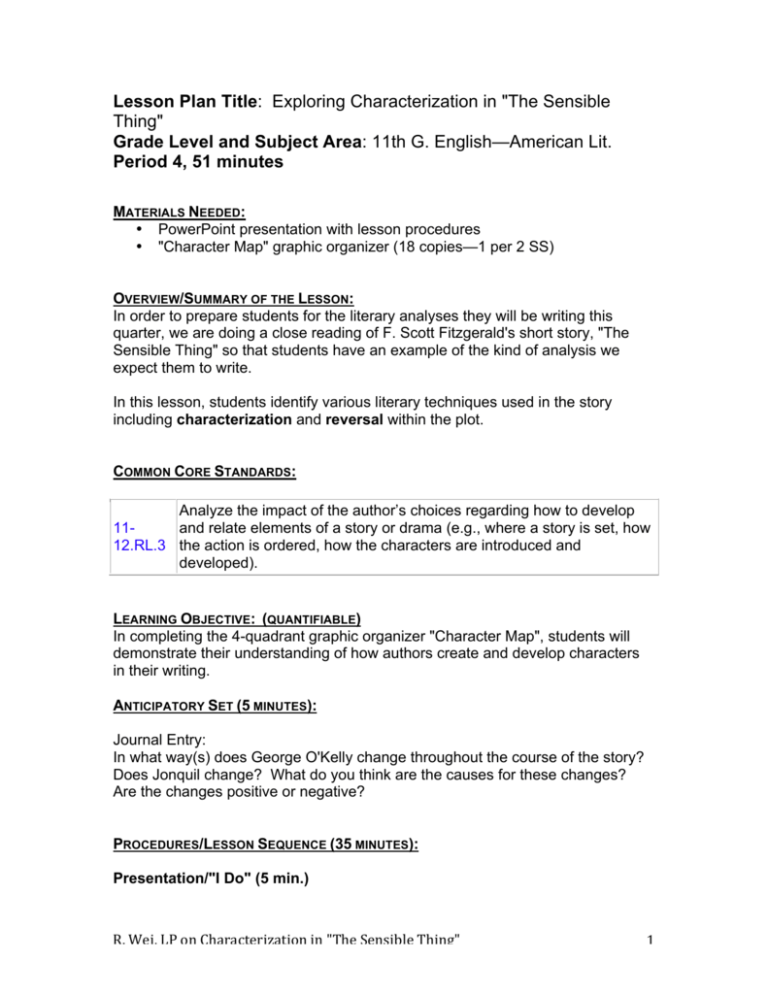
Lesson Plan Title: Exploring Characterization in "The Sensible Thing" Grade Level and Subject Area: 11th G. English—American Lit. Period 4, 51 minutes MATERIALS NEEDED: • PowerPoint presentation with lesson procedures • "Character Map" graphic organizer (18 copies—1 per 2 SS) OVERVIEW/SUMMARY OF THE LESSON: In order to prepare students for the literary analyses they will be writing this quarter, we are doing a close reading of F. Scott Fitzgerald's short story, "The Sensible Thing" so that students have an example of the kind of analysis we expect them to write. In this lesson, students identify various literary techniques used in the story including characterization and reversal within the plot. COMMON CORE STANDARDS: Analyze the impact of the author’s choices regarding how to develop 11and relate elements of a story or drama (e.g., where a story is set, how 12.RL.3 the action is ordered, how the characters are introduced and developed). LEARNING OBJECTIVE: (QUANTIFIABLE) In completing the 4-quadrant graphic organizer "Character Map", students will demonstrate their understanding of how authors create and develop characters in their writing. ANTICIPATORY SET (5 MINUTES): Journal Entry: In what way(s) does George O'Kelly change throughout the course of the story? Does Jonquil change? What do you think are the causes for these changes? Are the changes positive or negative? PROCEDURES/LESSON SEQUENCE (35 MINUTES): Presentation/"I Do" (5 min.) R. Wei, LP on Characterization in "The Sensible Thing" 1 • SS take Cornell Notes What is characterization? The use of literary techniques to create a character. 1. direct description (e.g. reader is told about C's appearance, habits, dress, background, personality, motivations, etc.) 2. portrayal of characters' behavior (e.g. reader draws own conclusions from C's actions & speech) 3. representations of characters' internal states (e.g. writer reveals character's private thoughts and emotions through internal monologue) o dynamic characters—change throughout the story o static characters—do not change Introduce and model the graphic organizer "Character Map" "We Do Together" (5 min.) • Choose George or Jonquil • In PAIRS, fill in as much as you can of each of the 4 areas • Include before & after characterizations (there is a plot reversal) • Please include PAGE #s • In GROUPS share what you have with each other. • Send out SCOUTS to other groups to supplement what you have. One scout per group at a time. Small Group Work "You Do Together" (25 min.) • ~ 10 min. Students work in pairs within small groups to identify the different ways (actions, words, attitude, appearance) that Fitzgerald characterizes George or Jonquil in the story. • ~ 5 min. SS share within small groups • ~ 5 min. groups send SCOUTS to other groups to collect more info. CLOSURE SET "WE DO" (5 MINUTES): • What have we learned about characterization? • How did George change? • How did Jonquil change? • What techniques does Fitzgerald use to show the changes? • Why is it important for us to be able to identify the elements of characterization? ASSESSMENTS "YOU DO ON YOUR OWN" • the next Journal entry will ask students to recall and reflect on what they learned in this lesson. • HW: Summary & Reflection for CN due Mon. ADAPTATIONS/SPECIAL NEEDS MODIFICATIONS R. Wei, LP on Characterization in "The Sensible Thing" 2 Students who learn better visually will benefit from the PowerPoint presentation format as well as from the use of the graphic organizer. Kinesthetic learners will find the "scouting" part of small group work to be more engaging than other, less hands-on modalities. Students who have difficulty understanding instruction or content will need to have concepts broken down and chunked. ELL students or students who still have trouble understanding the concepts might benefit from teacher and/or peer explanations that use simplified language. R. Wei, LP on Characterization in "The Sensible Thing" 3
